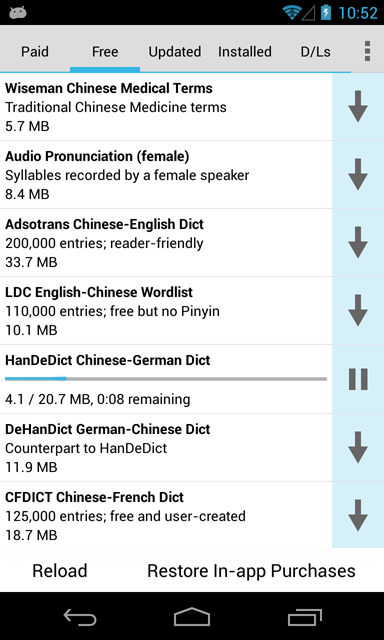
Pleco for Android Instruction Manual : Advanced Tutorial
This tutorial will take you through some additional Pleco features not covered in the Basic tutorial, including additional search types and paid add-ons like handwriting recognition, stroke order, and audio.
Tap on the menu button and select "Add-ons" to jump to the Pleco Add-ons screen, go back into the "Free" tab, and download the HanDeDict Chinese-German dictionary. (don't worry if you don't speak German, you can delete this later)

Now, tap on the menu button and select "Settings," and scroll down to "Manage Dictionaries":
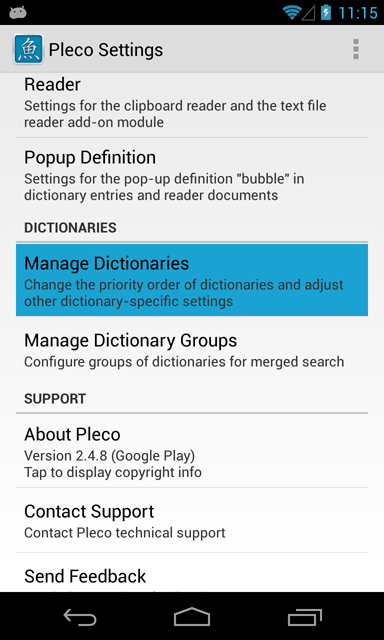
Tap on that to bring up this screen:

This screen lets you view and rearrange your dictionaries - you can also access various additional options (documented in the main dictionary manual) by tapping on an individual dictionary's name.
You'll see that HanDeDict is currently at the bottom of the list; drag it to the top:
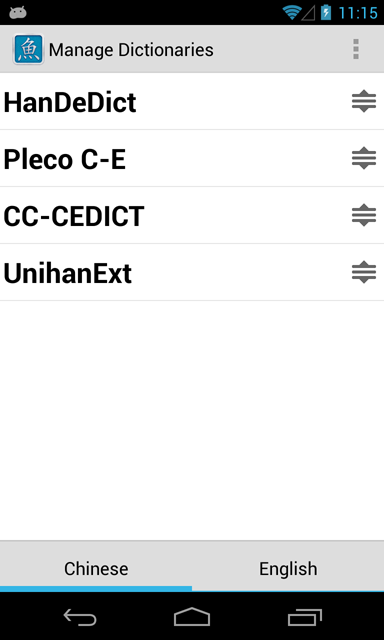
Tap on the menu button and select "Dict" to switch back into the dictionary, then enter "nihao" again:
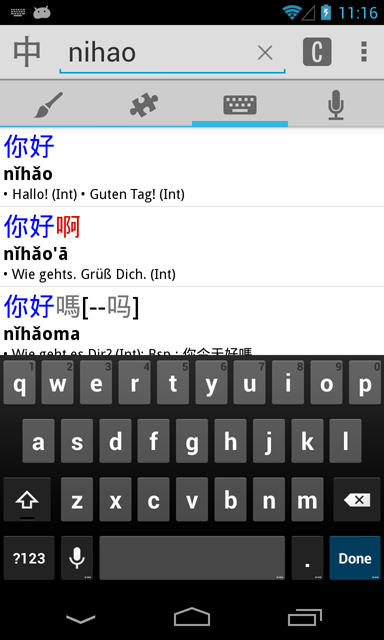
You'll see that the German results are now coming up by default. Go back into Manage Dictionaries and drag HanDeDict back down to the bottom, then go back into the dictionary search results, clear and re-enter "nihao" and you should see something like this:

Pleco is now showing the "nihao" definition from PLC by default, but it's still pulling entries from HanDeDict when there are words in it that aren't in any other dictionary.
To delete HanDeDict, go back into "Add-ons," select the "Installed" tab, and tap on HanDeDict, then tap on "Delete."
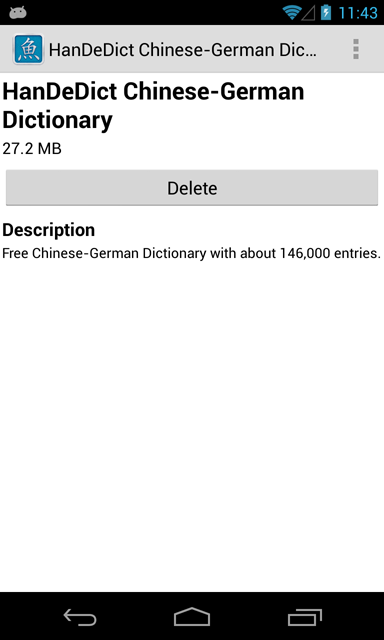
One unique Pleco feature is the ability to combine Chinese characters and Pinyin syllables in a single search query; this works just as quickly as a character-only or Pinyin-only search, and is extremely useful if you recognize one character in a word but don't recognize the other (since you can use handwriting/radical input for the character you don't know but switch to the faster keyboard input for the character you do know).
Clear the Search Field, switch to radical input, tap on the 亻 radical (midway through the radicals that come after ②), then tap on 什 (first character after ②). Switch to keyboard input and enter "me," so that you end up with the search query "什me". You should now see 什么, "what," listed as the first search result:
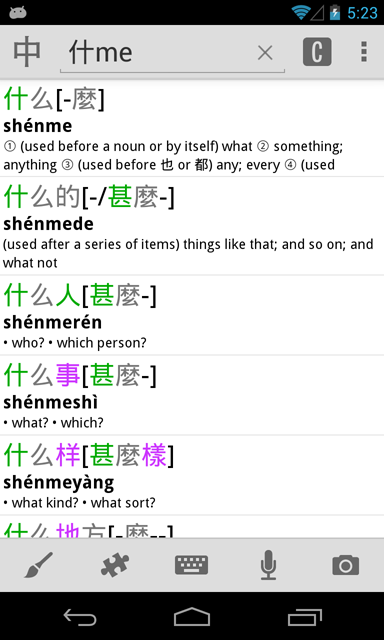
This also works with the Pinyin syllable first and the character second. However, in order to keep our database indexes from getting too big, this feature currently only works in the first three characters/syllables of a word; everything from the third character/syllable onwards has to be the same thing (character or Pinyin).
Go back into Add-ons and download the LDC English-Chinese dictionary, again from the "Free" tab. Go back into the dictionary search screen and do a search for "large":
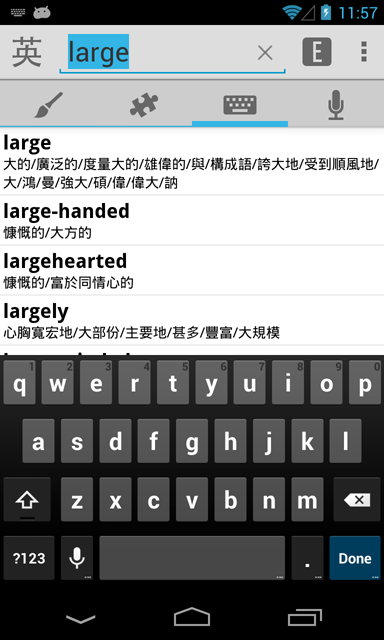
You'll see that results are now coming up with English rather than Chinese headwords, and that the dictionary switch icon is now an E - this is an English-to-Chinese dictionary, so instead of typing in an English word and getting a list of Chinese-English dictionary entries that contain it, you're getting a list of English-Chinese dictionary entries that match it, each of which offers a list of Chinese translations for its headword. This free one is quite simple, but others are available through "Add-ons" with lots more data - example sentences, detailed usage explanations, etc.
Even with an E-C dictionary installed, you can still view results in the old mode by tapping on the dictionary switch button; do that now to get this:

To insert a wildcard into a search term, simply enter a "?." ? acts as a substitute for a single character or Pinyin syllable; "?hao" would look for words where the second syllable is "hao," but exclude those where the third or fourth syllable is "hao."
Tap on the Search Field, type "bu," type an ? symbol, then type "bu" again, so you'll be left with "bu?bu" in the Search Field. Tap "Done" to view a full page of search results:

This is a list of every word in which the first and third syllables are pronounced "bu."
Pleco also supports multi-character wildcards (wildcards that can replace anywhere from 0-3 characters). The multi-character wildcard is represented by "*"; try it now with the search "*lue":

This is a list of every word in which "lüe" appears in one of the first four syllables.
A note on 'ü' - to spare our users from confusion, by default we treat 'u' and the umlaut version 'ü' the same in searches, even though they sound different in Pinyin (lu/lü, nu/nü, etc). If you prefer that Pleco keep these syllables separate, go into Settings / Dictionary / Search settings / Input processing and turn off the "Combine umlauts" option. You can then enter a ü either as an actual 'ü' (if your device's keyboard supports it) or as a 'v'.
You can change the wildcards to different symbols in Settings / Dictionary / Search settings / Wildcards if there are other symbols that you prefer or that are easier to enter with your device's keyboard.
Pleco includes a powerful "full-text search" feature to let you search for words that appear anywhere in dictionary entries, rather than just their headwords.
We've already seen a little bit of full-text searching with English-to-Chinese, but full-text searches can actually be used for Chinese too, and can be used for English even if you do have a dedicated English-to-Chinese dictionary installed.
Full-text searches are initiated by typing a '#' at the start of the search term. (like the wildcards, this character can be changed - Settings / Dictionary / Search settings / Full-text)
Clear the Search Field again, type a # with the keyboard, then switch to radical input, tap on the second radical listed (vertical line, 丨), and tap on 个 (first character after ②) twice to enter two copies of it in the Search Field. Tap "Done" to view the results:
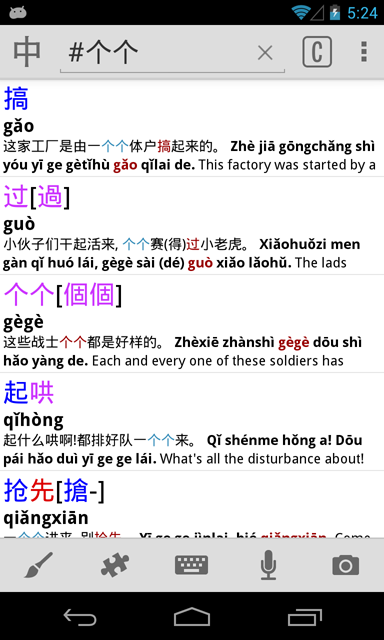
You'll see all of the entries containing "个个" listed, with the 个个 highlighted in each definition. Tap on the first result and you'll see each 个个 highlighted in it as well:
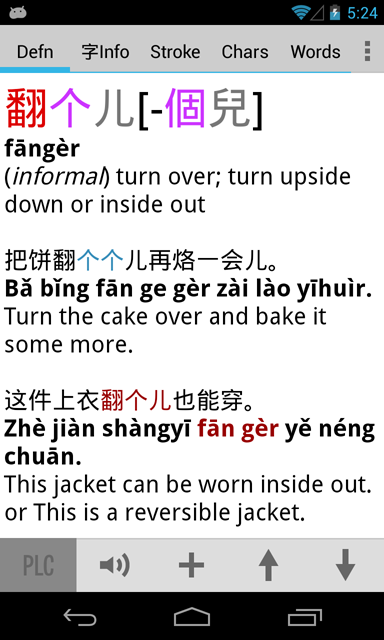
Tap on your device's menu button and tap "Settings."

Tap "General" here to be taken to another settings screen:
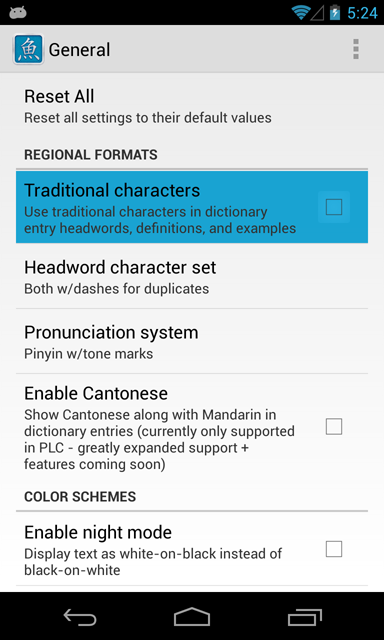
Tap "Traditional characters" here to put Pleco in traditional-character mode. This does not affect dictionary searches - Pleco supports simplified- and traditional-character searches regardless of how this is configured - but it does change the character set in which dictionary entries are displayed.
By default, both character sets are displayed for each dictionary headword, but with the character set you haven't currently selected enclosed by [] brackets; characters that are the same in both sets are replaced inside of the brackets by -s. (you can change this in Settings / General / Regional Formats) Characters in definitions, example sentences, and cross-reference links will display only in the currently-selected character set.
Two other useful items on this screen are "Pronunciation system," which can be used to switch from Pinyin to Zhuyin if you prefer to use that, and "Enable Cantonese," a (currently experimental) option to display Cantonese transliterations for dictionary headwords along with mandarin. To enter a search term in Zhuyin, simply find and download a Zhuyin input keyboard for your phone - Pleco will automatically detect when you've typed Zhuyin in the search field and process it appropriately.
Tap on a character in one of the example sentences to bring up the pop-up reader screen again:
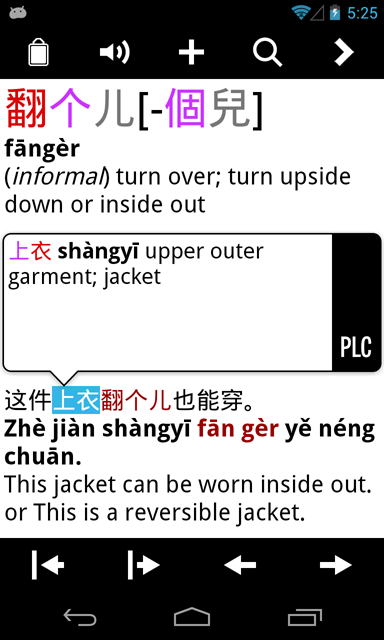
We already talked about how to move the highlight around and bring up the Char Info screen in the Basic tutorial, but there are some other useful functions here too.
Tap on the button at the top left corner of the screen to copy the highlighted text to the system clipboard:
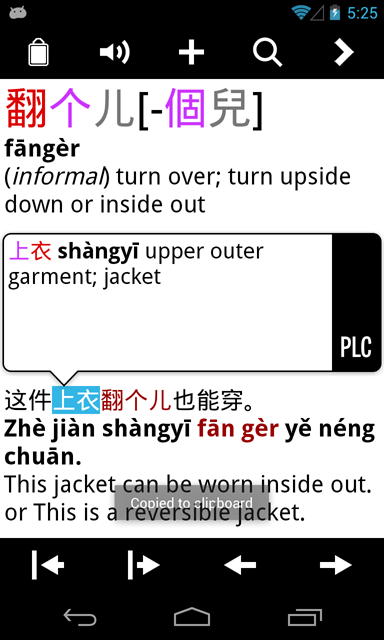
This is helpful if you want to copy it into another app.
At the right of the popup definition you'll notice another dictionary abbreviation icon (PLC or CC), and possibly also a pair of triangles pointing up and down. Tap on the dictionary icon to switch between dictionaries, and tap on the triangles to scroll through the matching entries (if there are more than one) in the current dictionary.
Tap on the ![]() button to bring up the popped-up definition in its own dedicated screen:
button to bring up the popped-up definition in its own dedicated screen:
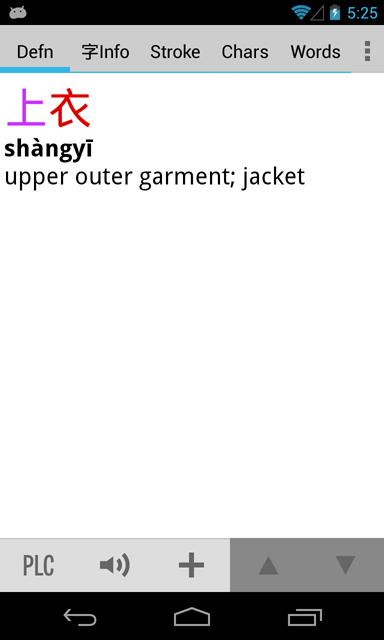
Tap on your device's back button to return to the previous screen.
Finally, tap on the ![]() button to drop back to the main dictionary screen and do a new search for the highlighted word:
button to drop back to the main dictionary screen and do a new search for the highlighted word:

Tilt your device sideways and the dictionary screen should rotate to look like this:
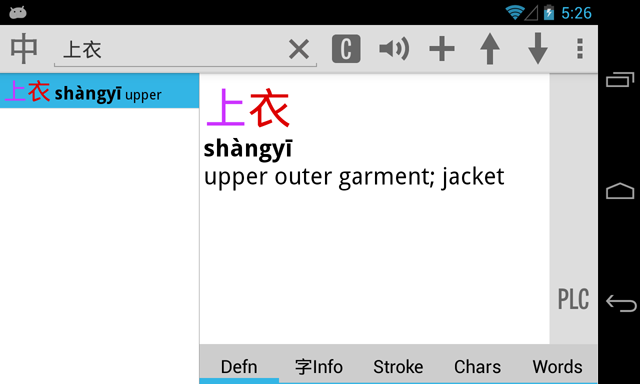
This offers an alternate interface for searching for / displaying dictionary entries, one that takes advantage of the extra screen width to put definitions and result lists on the same screen. The currently-selected dictionary entry is highlighted in the list of entries, and its definition is shown next to the list.
To view another entry, simply tap on its entry in the list. Tap on the speaker or + buttons to play audio for the entry or add it to flashcards.
Just as in the separate definition screen, you can tap on Chinese characters in the definition to look them up in Char Info / cross-reference them / etc.
If you don't like this interface and want to keep things working the same way regardless of how the screen is oriented, go into Settings / Dictionary / Main screen interface / Landscape orientation and turn off "two-panel layout."
Tilt your device back to vertical orientation, press the menu button, and tap "History" to view your recent entry / search history:
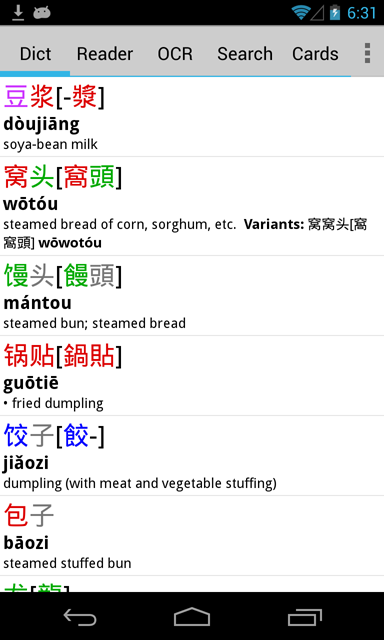
Select the "Dict" tab at the top of the screen to view a list of recently-viewed entries, with the most recent at the top. Tap on any of them to view their definitions in a separate screen.
Select the "Searches" tab to view a list of recently-entered search queries; tap on one of those to insert it into the Search Field and re-do the search.
"OCR" and "Reader" show entries recently viewed via the OCR and document reader systems, and "Cards" shows recently-created flashcards.
Press your device's menu button and tap "Clear All" to clear out the contents of a particular history tab.
Press your device's back button to exit the history screen.
The remainder of this tutorial deals with the paid stroke order / handwriting add-ons.
You can try out the handwriting recognizer for free by going to "Add-ons" and downloading the demo of "Handwriting Recognizer" under "Paid," then accessing handwriting per the instructions below - you won't be able to actually look up characters in the dictionary this way, but you can try drawing them and see how accurately the system recognizes what you draw. Likewise for stroke order - you can download the demo version, but until you purchase it you'll only be able to view stroke order for a few random characters instead of for the character you want.
Open up the Search Field and tap on the paintbrush icon to bring up the handwriting recognizer:

You can use the handwriting recognizer to enter / look up characters simply by drawing them on the screen with your finger. We'll start with an easy one: draw the character 三 "three" by drawing three horizontal lines, each left-to-right, beginning with the top line, then the middle line, then the bottom line.

You'll notice that the list of potential matches at the bottom of the screen updates after each stroke. Tap on 三 (should be the first character listed) to clear what you've drawn and enter 三 in the Search Field:
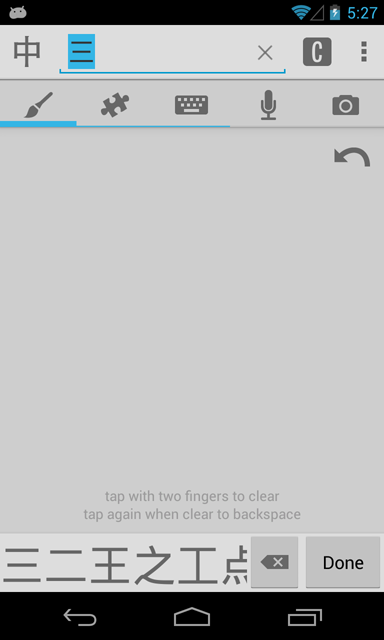
Tap on the backspace ![]() button to delete the character you just entered.
button to delete the character you just entered.
Now draw 十 "ten" - draw the horizontal line from left-to-right, then the vertical line from top-to-bottom:

十 should again be the first character listed. This time, instead of tapping on that character, simply tap anywhere in the drawing area with two fingers - it doesn't matter where, just make sure both fingers are touching the screen somewhere within the drawing area. This will clear what you've drawn, leaving 十 in the Search Field, and allow you to immediately begin entering another character.
Tap on the screen with two fingers again and that 十 should now be deleted from the Search Field; when the drawing area is empty, tapping on it with two fingers causes the software to backspace and erase the previous character entered.
So basically, if you:
Note that if you tap the list of candidate characters at the bottom of the screen and drag your finger to the left / right, you can scroll it to see additional characters, so it may be worth checking those before you clear your input / try again.
To view the stroke order for a character, tap on it in a dictionary definition and tap on the "Stroke" tab at the top of the screen. (this is a paid add-on, with an extra database that needs to be downloaded from the "Add-ons" tab before it will appear)
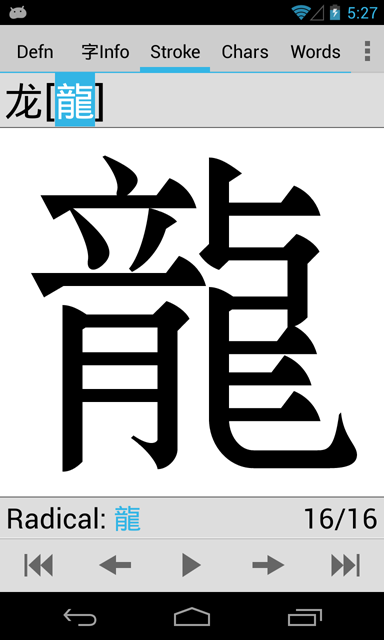
Notice that both the traditional and simplified versions of this character 龙 are displayed at the top - you can tap on the simplfied one to view its stroke order instead.
Tap on the play ![]() button at the bottom of the screen to animate the strokes in the character one-by-one. While the strokes are animating, this changes to a pause button - tap on that to pause playback.
button at the bottom of the screen to animate the strokes in the character one-by-one. While the strokes are animating, this changes to a pause button - tap on that to pause playback.
The left and right arrows go back / forward by one stroke at a time, while the rewind button takes you back to before the first stroke and the fast forward button takes you forward to the last stroke.
Purchasing the stroke order add-on also gets you access to our experimental character component search feature; to access that, tap on the "Chars" tab. The "Components" section of that screen gives you a list of other characters contained inside of this character (玉 "jade" inside of 国 "country" for example) and the "Containing" section lists other characters which contain this one.
That's the end of this tutorial. You can continue on to the Document Reader tutorial, which goes into more details about using Pleco's built-in document reader, the Flashcards tutorial, which explains how to create and test yourself on vocabulary lists, or dive right into the Dictionary, Reader, Flashcards, Add-ons, or Settings reference manuals.
Return to Table of Contents